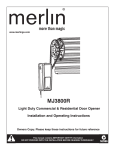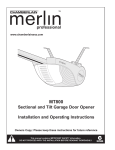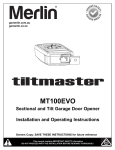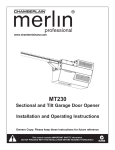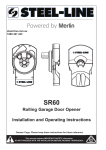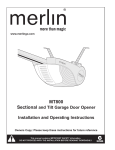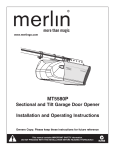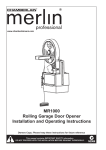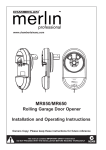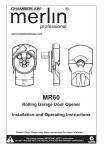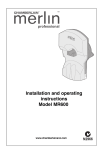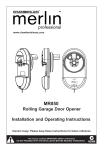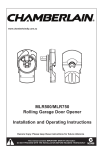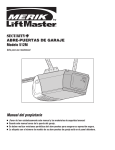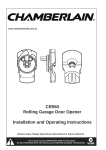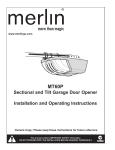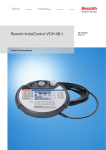Download Merlin MJ3800 Operating instructions
Transcript
gomerlin.com.au gomerlin.co.nz MJ3800 Residential & Light Duty Commercial Door Opener Installation and Operating Instructions Owners Copy: Please keep these instructions for future reference This manual contains IMPORTANT SAFETY information DO NOT PROCEED WITH THE INSTALLATION BEFORE READING THOROUGHLY START BY READING THESE IMPORTANT SAFETY INSTRUCTIONS WARNING • Failure to comply with the following instructions may result in serious personal injury or property damage. • Read and follow all instructions carefully. • The garage door opener is designed and tested to offer safe service provided it is installed and operated in strict accordance with the instructions in this manual. These safety alert symbols mean WARNING : A possible risk to personal safety or property damage exists. Keep garage door balanced. Do not let the garage door opener compensate for a binding or sticking garage door. Sticking, binding or unbalanced doors must be repaired before installing this opener. The Protector SystemTM must be used for all installations where the closing force as measured on the bottom of the door is over 400 N (40 kgf). Excessive force will interfere with the proper operation of the Safety Reverse System or damage the garage door. SPECIAL NOTE: Merlin strongly recommends that The Protector SystemTM be installed on all garage door openers. Do not wear rings, watches or loose clothing while installing or servicing a garage door opener. Wear gloves, safety goggles and suitable protective clothing where appropriate. After installation, ensure that the parts of the door do not extend over public footpaths or roads. Install the wireless wall control (or any additional wall control) in a location where the garage door is visible, at a height of at least 1.5 m and out of the reach of children. Do not allow children to operate push button(s) or transmitter(s). Serious personal injury from a closing garage door may result from misuse of the opener. Frequently examine the door installation, in particular cable, springs and mountings for signs of wear, damage or imbalance. Do not use if repair or adjustment is needed since springs and hardware are under extreme tension and a fault can cause serious personal injury. To avoid serious personal injury from entanglement, remove all ropes, chains and locks connected to the garage door before installing the door opener. Permanently fasten the Warning Labels in Prominent Places, adjacent to Wall Controls and on manual release mechanism as a reminder of safe operating procedures. Installation and wiring must be in compliance with your local building and electrical codes. The safety reverse system test is very important. Your garage door MUST reverse on contact with a 40 mm obstacle placed on the floor. Failure to properly adjust the opener may result in serious personal injury from a closing garage door. Repeat the test once a month and make any necessary adjustments. Activate opener only when the door is in full view, free of obstructions and the opener is properly adjusted. No one should enter or leave the garage while the door is in motion. Automatic Door- The door may operate unexpectedly, therefore do not allow anything to stay in the path of the door. Do not allow children to play near the door, or with door controls. Keep remotes away from children. This appliance is not intended for use by persons (including children) with reduced physical, sensory or mental capabilities, or lack of experience and knowledge, unless they have been given supervision or instruction concerning use of the appliance by a person responsible for their safety. Disconnect electric power to the garage door opener before making repairs or removing covers. If the supply cord is damaged, it must be replaced by the manufacturer, its service agent or similarly qualified persons in order to avoid hazard. Use the Manual Release only for the seperation of the carriage from the drive and - if possible - ONLY with the door closed. Do not use the red handle to push the door up or pull it down. Operation of the emergency release can lead to uncontrolled movements of the door, if springs are weak or broken or if the door is unbalanced. Mount the release handle of the emergency release at a height less than 1.8 m from the floor. This opener should not be installed in a damp or wet space exposed to weather. To avoid damage to very light doors (such as fibreglass, aluminium or steel doors), an appropriate reinforcement should be added. To do so, contact the door manufacturer. SAVE THESE INSTRUCTIONS NOTE: If your garage has no service entrance door, a CM1702 outside quick release must be installed. This accessory allows manual operation of the garage door from outside in case of power failure. CONTENTS PAGE SAFETY INSTRUCTIONS . . . . .2 CARTON INVENTORY . . . . . . .3 ACCESSORIES . . . . . . . . . . . 3 SPECIFICATION . . . . . . . . . . .4 TOOLS REQUIRED . . . . . . . . .4 PREPARE & TEST THE DOOR . .4 DOOR REQUIREMENTS . . . . . .5 ASSEMBLY . . . . . . . . . . . . . . .6 INSTALLATION . . . . . . . . .7-10 CONNECT ELECTRIC POWER .10 INSTALL MULTI-FUNCTION DOOR 2 CONTROL . . . . . . . . . . . . . .10 INSTALL THE PROTECTOR SYSTEM . . . . . . . . . . . . . . .11 AUTO CLOSE . . . . . . . . . . . .13 ADJUSTMENT . . . . . . . . .14-17 WIRELESS PROGRAMMING 18-19 REPAIR PARTS . . . . . . . . . . .20 DIAGNOSTIC CHART . . . . . . .21 TROUBLESHOOTING . . . . . . .22 CARE OF YOUR OPENER . . . . 23 OPERATION OF YOUR OPENER23 WARRANTY . . . . . . . . . . . . .24 CARTON INVENTORY Your door opener is packaged in one carton which contains the opener and the parts illustrated below. Note that accessories will depend on the model purchased. If anything is missing, carefully check the packing material. 2 x C945 3ch rolling code transmitters CM128 Wireless Wall Button Opener Manual TM LOCK CM475 Battery Backup Unit Multi function door control LIGHT Hardware Inventory INSTALLATION HARDWARE Hex Screw #14-10x1-7/8" (4) Screw #6x-1" (2) Hex Screw #6x1-1/4” (2) Carriage Bolt 1/4"-20x1/2" (2) Pan Head Screw 1/4"-20x1/2" (2) Hex Head Screw #8x1" (2) Self Tapping Screw #10-32 (2) Wall Anchor (2) Wall Anchor (Screw-In) (2) Handle Rope Insulated Staples (10) Lock Template PROTECTOR SYSTEMTM (IR) INSTALLATION HARDWARE Screw 10-32x3/8" (4) Carriage Bolt 1/4"-20x1/2" (4) Wing Nut 1/4"-20 (2) Hex Nut 10-32x3/8" (4) Hex Nut 1/4-20 (4) Hex Head Screw 1/4-20x1-1/2" (2) Hex Head Screw 14-10 x 1-1/2" (4) Insulated Staple (10) ACCESSORIES CM844 C940 CM128 1 2 C943 3 C945 4 5 845AML LOCK C98 LIGHT LOCK LIGHT 6 C840 7 (1) Model CM844 (2) Model CM128 (3) Model C940 (4) Model C943 (5) Model C945 (6) Model 845AML or Model C98 CM1702 C77 8 9 CM475 760E 10 11 4 Channel remote control Wireless Wall Button 1 Channel visor remote control 3 Channel visor remote control 3 Channel mini remote control Multi-Function Door Control Motion Detecting Control Panel (7) Model C840 (8) Model C77 (9) Model CM1702 (10) Model 760E (11) Model CM475 (12) Model ANT4X-1 3 12 Keyless Entry System TM The Protector System Quick Release Lock Outside Keyswitch Battery Backup 433MHz Antenna, cable and adaptor PREPARING YOUR DOOR Before you begin: To prevent possible SERIOUS INJURY or DEATH: • ALWAYS call a trained door systems technician if door binds, sticks or is out of balance. An unbalanced door may not reverse when required. • NEVER try to loosen, move or adjust door, door springs, cables, pulleys, brackets or their hardware, ALL of which are under EXTREME tension. • Disable ALL locks and remove ALL ropes connected to the door BEFORE installing and operating the door opener to avoid entanglement. • This device is not intended for use by small children or infirmed persons without supervision. • young children should NOT be permitted to play with the opener or transmitters. • Disable locks. • Remove any ropes connected to door. • Complete the following test to make sure your door is balanced and is not sticking or binding: 1. Lift the door about halfway as shown. Release the door. If balanced, it should stay in place, supported entirely by its springs. 2. Raise and lower the door to see if there is any binding or sticking, 20 Kgf is the absolute maximum allowable force to raise or lower the door in any position. IF YOUR DOOR BINDS, STICKS OR IS OUT OF BALANCE, CALL A TRAINED DOOR SYSTEMS TECHNICIAN. 3. Verify equal cable tension on each side of door. Cable tension should remain equal during the entire travel of the door. To prevent damage to door and opener: • ALWAYS disable locks BEFORE installing and operating the opener. Specifications Volts: 230-240 ~ V 50 Hz Power: 145 Watts Rated Load: 10Nm Fmax: 40Nm Max door height: 4.2m (14’) Max door width: 5.5m Max: area 16m2 Sectional Door Tools needed During assembly, installation and adjustment of the opener, instructions will call for hand tools as illustrated below. 1 Drill Pliers 2 Tape Measure Wire Cutters 3/16" and 1/8" Hex Key Wrench 5/32", 3/16", 5/16" and 3/4" Drill Bits Stepladder Pencil Screwdriver 1/4", 5/16" & 3/8" Sockets and Wrench with 200mm Extension Torque Meter (not shown) Claw Hammer Adjustable End Wrench Please note this opener contains both imperial and metric fasteners. 4 Needle Nose Pliers DOOR REQUIREMENTS Survey the area to see if any of the conditions below apply to your installation. Additional materials may be required. You may find it helpful to refer back to this page as you proceed with the installation of your opener. Depending on your requirements, there are several installation steps which may call for materials or hardware not included in the carton. This opener is compatible with: • Doors that use a torsion bar, springs and a door no more than 4.2m (14’) high. • 100mm - 150mm drums (4” to 6”), NOT TO BE USED on tapered drums over 150mm (6”). • High lift and standard lift sectional doors up to 4.2m (14’) high. • Doors up to 5.5m (18’) wide. • Doors up to 16m2 (170 sq ft) • 25mm (1”) torsion bar only. • Review or inspect proposed installation area. Opener can be installed on left or right side of door. Select the side that meets the requirements listed below. • Must have minimum of 64mm (2 1/2”) between the wall and the center of the torsion bar. • Must have minimum of 76mm (3”) between the ceiling and the center of torsion bar. Opener • Must have minimum of 203mm (8”) between the side wall (or obstruction) and the end of torsion bar. • The torsion bar must extend at least 25mm to 100mm (1” to 4”) past the bearing plate. • An electric outlet is required within 1.8m (6’) of the installation area. If outlet does not exist, contact a qualified electrician. • Depending upon building’s construction, extension brackets or wood blocks may be needed to install safety reversing sensors. • A model CM475 EverChargeTM Standby Power Unit (SPU) is strongly recommended if there is no access door to the building, as this opener cannot be used in conjunction with an external emergency release mechanism. • Any gap between the floor and the bottom of the door must not exceed 6mm (1/4”). Otherwise the safety reversal system may not work properly. NOTE: Inspect the torsion bar while the door is raised and lowered. It is important that there is no noticeable movement up and down or left and right. If this type of movement is not corrected, life of this opener will be greatly reduced. Cable Tension Monitor Torsion Spring Drum Access Door Powered Door Lock Safety Reversing Sensor Safety Reversing Sensor Gap between floor and bottom of door must not exceed 6 mm (1/4”) 5 Wireless wall button ASSEMBLY STEP 1 Attach the Collar to the Opener To avoid installation difficulties, do not run the door opener until instructed to do so. • Loosen the collar screws. • Attach collar to either the left or the right side of the opener. Depending on Left or Right hand installation ensure that the collar is seated all the way on motor shaft until stop is reached (Figure 1). • Position the collar so that the screws are accessible when attached to the torsion bar. • Tighten both sides of collar screws equally (Figure 2) to secure collar to the opener (16Nm-19Nm of torque). • Do not tighten set screws as yet. NOTE: Nylon Patch has been added to the collar screws, so it is normal for some thread resistance to be evident. To prevent possible SERIOUS INJURY or DEATH, the collar MUST be properly tightened. The door may not reverse correctly or limits may be lost due to collar slip. Collar Screw Collar Screw Set Screw Set Screw Collar Screw Collar Screw Left hand Right hand installation installation Figure 1 Figure 2 RIGHT ASSEMBLY STEP 2 WRONG Attach Mounting Bracket to Opener • Loosely attach slotted side of mounting bracket to the same side of the opener as the collar, using self-threading screws provided. NOTE: Do not tighten until instructed. Illustrations shown are for left side installation. HARDWARE SHOWN ACTUAL SIZE Socket Wrench Screw #10-32 Alternate Mounting Kit (NOT SUPPLIED): G480LM This kit allows model MJ3800 to be mounted below the torsion bar in the case where the torsion bar is not round or the normal mounting area is obstructed. 6 INSTALLATION IMPORTANT INSTALLATION INSTRUCTIONS WARNING To reduce the risk of SEVERE INJURY or DEATH: 1. READ AND FOLLOW ALL INSTALLATION WARNINGS AND INSTRUCTIONS. 2. Install door opener ONLY on properly balanced and lubricated the door. An improperly balanced door may not reverse when required and could result in SEVERE INJURY or DEATH. 3. ALL repairs to cables, spring assemblies and other hardware MUST be made by a trained door systems technician BEFORE installing opener. 4. Disable ALL locks and remove ALL ropes connected to the door BEFORE installing opener to avoid entanglement. 5 Mount emergency release handle no higher than 1.8m above floor. 6. NEVER connect the door opener to power source until instructed to do so. 7.NEVER wear watches, rings or loose clothing while installing or servicing opener. They could be caught in the door or opener mechanisms. 8. Install wall-mounted door control: • within sight of the door. • out of reach of children at minimum height of 1.5 m. • away from ALL moving parts of the door. 9. Place entrapment warning label on wall next to multi function door control. 10.Place manual release/safety reverse test label in plain view on inside of the door. 11.Upon completion of installation, test safety reversal system. Door MUST reverse on contact with a 40mm (1 1/2”) high obstacle placed on the floor. INSTALLATION STEP 1 Position the Opener To prevent possible SERIOUS INJURY or DEATH: • Concrete anchors MUST be used if mounting bracket into masonry. • NEVER try to loosen, move or adjust the door, springs, cables, pulleys, brackets or their hardware, ALL of which are under EXTREME tension. • ALWAYS call a trained door systems technician if the door binds, sticks or is out of balance. An unbalanced door might not reverse when required. • Opener MUST be mounted at a right angle to the torsion bar to avoid premature wear on the collar. 1. Close the door completely. 2. Slide the opener with collar over the end of the torsion bar. Ensure that the collar does not touch the bearing plate. Check to make sure the mounting bracket is located on a solid surface such as wood, concrete or door/flag bracket. Snug collar screws to help assure proper alignment of opener. Mark the bracket holes. It may be necessary to cut the torsion bar if it is too long or damaged. 3. Loosen collar screws from torsion bar and remove the opener. Drill 5mm (3/16”) pilot holes at the marked locations. Drill through steel plate if needed. 4. Reinstall the opener by sliding the collar over the torsion bar until pilot holes align with bracket. Securely tighten collar screws that attach to the torsion bar to 16Nm19Nm of torque. Securely tighten both set screws firmly, without damaging the opener. 5. Fasten bracket securely with 14-10x1-7/8" screws. Tighten all mounting bracket hardware. NOTE: The opener does not have to be flush to wall, but it is essential it is mounted perfectly square to the torsion bar. This will ensure smooth operation with minimum stress at the connecting collar mount. 6. Use a staple to secure the antenna wire to prevent antenna from being entangled in a door roller. Torsion Bar Staple 7 INSTALLATION STEP 2 Attach the Emergency Release Rope and Handle To prevent possible SERIOUS INJURY or DEATH from a falling door: • If possible, use emergency release handle to disengage door ONLY when door is CLOSED. Weak or broken springs or unbalanced door could result in an open door falling rapidly and/or unexpectedly. • NEVER use emergency release handle unless the doorway is clear of persons and obstructions. • Thread one end of the rope through the hole in the top of the red handle so “NOTICE” reads right side up as shown. Secure with an overhand knot at least 25mm (1") from the end of the rope to prevent slipping. • Thread the other end of the rope through the loop in the emergency release cable. • Adjust rope length so the handle is no higher than 1.8m (6’) above the floor. Secure with an overhand knot. NOTE: If it is necessary to cut the rope, heat seal the cut end to prevent unraveling. Opener Emergency Release Cable Overhand Knot Warning Label Emergency Release Handle INSTALLATION STEP 3 %' Rope Overhand Knot Install powered door lock The lock is used to prevent the door from being manually opened once the door is fully closed. 1.Select a door roller to mount the lock above. Check for clearance. If possible select a roller on the same side of the door as the opener. The second roller up from the bottom is ideal in most installations. 2.Ensure the door track surface is clean and adhere lock template with bottom edge just above the highest point on the roller (Figure 1). 3.Drill holes as marked on the template. 4.Fasten powered door lock to the outside of the door track with hardware provided. 5.Run bell wire up wall to opener. Use insulated staples to secure wire in several places. 6.Plug connector into the opener (Figure 2). NOTE: Lock must be mounted within 3m (10') of the power head. TOP DRILL 8mm Approx. 7.6cm 132A2505 DRILL 19mm DRILL 8mm (3”) Garage Door Track TOP DRILL 5/16" Staples 8 Figure 2 DRILL 3/4" 132A2505 Figure 1 HARDWARE SHOWN ACTUAL SIZE Lock Screw 1/4-20 x 1/2" (2) WARNING 016+ Roller DRILL 5/16" Lock Template INSTALLATION STEP 4 Figure 1 Attach the Cable Tension Monitor (Required) Your MJ3800 is supplied with a cable tension monitor. This safety device is supplied to monitor the cable for ANY slack that may occur and will reverse the door when excessive slack is detected, eliminating service calls. The cable tension monitor MUST be connected and properly installed before the door opener will move in the down direction. NOTE: The cable tension monitor is shipped for left side installation. It is preferred that the cable tension monitor be installed on the same side of the door as the opener. If required, it can be mounted on the opposite side of door. Remove the snap-ring holding the roller in place and reassemble it on the opposite side of the cable tension monitor. 1.Position the cable tension monitor as shown (Figures 1 and 2). The cable tension monitor should be located as close to the drum as possible. NOTE: There must be no obstructions in the installation area that prevent the cable tension monitor or the cable itself from closing completely when slack is detected. 2.Make sure cable tension monitor is located over a wood support member. NOTE: If the cable tension monitor can not be mounted into wood with the lag screws provided, it can be mounted into 25mm (1”) or greater pasterboard using the wall anchors (2) and the #8 hex head screws (2) provided in the hardware bag. 3.Mark and drill 5mm (3/16”) pilot holes for screws (pilot holes are not required for anchors). 4.Attach the cable tension monitor to the wall using the hardware provided. Make sure that the roller is on top of the cable. 5.Run bell wire to opener. Use insulated staples to secure wire in several places. 6.Connect bell wire to the green quick-connect terminals (polarity is not important) (Figure 3). NOTE: Cable must have tension through entire travel. Make sure there is no slack in cable on opposite side of the door during normal operation. If this condition exists, adjust cables as required. Opener Torsion Bar Drum Cable 2"-6" (5 cm15 cm) 1/8"-1/4" (3 mm-6 mm) Cable Tension Monitor Cable Tension Monitor Roller With Door Closed Preferred Orientation Figure 2 Wall Drum Cable 3/4" Min. (18 mm Min.) Figure 3 WHT/GRN WHT/GRN Cable Tension Monitor Strip wire (11mm) To insert or release wire, push in tab with screwdriver tip #8 He ho ) #6 (2 2) r( ew w re Sc r Sc nc d lA ea al W xH Staples ) (2 9 To prevent possible SERIOUS INJURY or DEATH from electrocution or fire: • Be sure power is not connected to the opener, and disconnect power to circuit BEFORE removing cover. • Door installation and wiring MUST be in compliance with ALL local electrical and building codes. • NEVER use an extension cord, 2-wire adapter or alter the plug in any way to make it fit outlet. Be sure the opener is grounded. • If the supply cord is damaged, it must be replaced by the manufacturer or it’s service agent or a similiarly qualified person in order to avoid harzard. INSTALLATION STEP 5 INSTALLING THE MULTI-FUNCTION WALL CONTROL To prevent possible SERIOUS INJURY or DEATH from a falling door: • If possible, use emergency release handle to disengage door ONLY when door is CLOSED. Weak or broken springs or unbalanced door could result in an open door falling rapidly and/or unexpectedly. • NEVER use emergency release handle unless the doorway is clear of persons and obstructions. Note: any connection to your MJ3800 should be voltage free and Normally open. There are 2 screw terminals on the back of the multifunction door control. Strip about 6mm of insulation from bell wire. Separate wires enough to connect the white/red wire to R terminal screw 1 and the white wire to W terminal screw 2. Fasten the multi-function door control to an inside garage wall with sheet metal screws provided. Drill 4mm holes and use anchors if installing into plasterboard wall. A convenient place is beside the service door and out of reach of children. Run the bell wire up the wall and across the ceiling to the garage door opener. Use insulated staples to secure wire. The receiver quick connect terminals are located on the control board. Connect the bell wire to the terminals as follows: white/red to red and white to white. Opener Red White To Door Control dry contact Quick-Connect Terminals RED INSTALLATION STEP 6 1 WHT 2 LOCK LIGHT Installing the Wireless Wall button (CM128) Control must be mounted out of the reach of children at a height of 1.5m with an unobstructed view of the door. • Ensure your MJ3800 opener is switched off whilst installing your wireless door control to prevent accidental activation. • Remove the cover from the CM128. • Mount CM128 as shown using the screws provided if mounting into a wall box (not provided). • If mounting directly on the wall use wall anchors (provided) to fix unit to the plasterboard wall. • Replace the cover plate and affix the warning label adjacent the wall controller. Disconnect power to the opener whilst installing this accessory to prevent accidental activation. Locate minimum 1.5m above the floor. Fix the emergency door release label adjacent to the opener. + NOTE: The wireless wall button supplied with your opener should be preprogrammed by the factory. If adding a new wireless wall button, program into the opener before mounting the unit. 10 INSTALLATION STEP 7 Install The Protector SystemTM Be sure power is not connected to the door opener BEFORE installing the safety reversing sensor. To prevent SERIOUS INJURY or DEATH from a closing door: • Correctly connect and align the safety reversing sensor. This required safety device MUST NOT be disabled. • Install the safety reversing sensor so beam is NO HIGHER than 100mm (4”) above the floor. When installed the safety reversing sensor must be connected and aligned correctly before the door opener will move in the down direction. This safety device is provided for your safety and should not be disabled. NOTE: The speed will also be increased by 1/3 in the down direction. INSTALLING THE BRACKETS Be sure power to the opener is disconnected. Figures 1, 2 and 3 show recommended assembly of bracket(s) and "C" wrap based on the wall installation of the sensors on each side of the door shown above, or on the door tracks themselves. Figures 4, 5 & 6 show variations which may fit your installation requirements better. Make sure the wraps and brackets are aligned so the sensors will face each other across the door. • Connect each assembly to a slotted bracket, using the hardware shown. Note alignment of brackets for left and right sides of the door. Finger tighten the lock nuts. • Use bracket mounting holes as a template to locate and drill (2) (4.8mm) diameter pilot holes on both sides of the door, (100mm). Max height is (100mm). • Attach bracket assemblies with 1/4"x1-1/2" lag screws as shown. • Adjust right and left side bracket assemblies to the same distance out from mounting surface. Make sure all door hardware obstructions are cleared. Tighten the nuts securely. Garage WALL Installation 1/4x1-1/2" Lag Screws Inside Garage Wall #10-32 Lock Nuts "C" Wrap figure 2 Mounting Bracket with Square Holes Garage DOOR Track Installation 1/4"-20 Lock Nuts Inside Garage Wall Garage Door Track Mounting Bracket with Square Holes Drill 3/8" (9,5mm) Holes "C" Shaped Wrap figure 3 1/4-20x1/2" Carriage Bolts Inside Garage Wall Mounting Bracket with Slot Alternate Wall Mount Mounting Bracket with Square Holes "C" Wrap Sensor Indicator Light Garage Floor Inside Garage Wall Indicator Light figure 4 Alternate Floor Mount Sensor Mounting Bracket with Square Holes Mounting Bracket with Slot Attach with concrete anchors (not provided) "C" Wrap Garage Floor figure 5 Wing Nut "C" Wrap ALL Installations Mounting Bracket With Square Holes Mounting Bracket with Slot 1/4"-20 Lock Nuts • Centre each sensor unit in a "C" wrap with lenses pointing toward each other across the door. • Secure sensors with the hardware shown in Figure 6. Finger tighten the wing nut on the receiving eye to allow for final adjustment. Securely tighten the sending eye wing nut. • Run wires from both sensors to the opener as shown on Page 12. Use insulated staples to secure the wire to the wall and ceiling. • Connect both sets of wires to the opener terminals as shown page 12. • Plug in the opener. If your opener has the Multi-Function Door Control, make sure the Lock Feature is off. Red indicator lights in both the sending and receiving eyes will glow if wiring connections and alignment are correct. If the indicator lights are flashing (and the invisible light beam path is not obstructed), alignment is required. • Loosen the receiving eye wing nut to allow slight rotation of unit. Adjust sensor vertically and/or horizontally until the red indicator light glows. • When indicator lights are glowing in both units, tighten the wing nut in the receiving eye unit. figure 1 1/4-20x1/2" Carriage Bolts (with square shoulder) "C" Wrap Wire Indicator Light #10-32x3/8" Screws 11 Sensor 1/4-20x1-1/2" Hex Bolt figure 6 CONNECT ELECTRIC POWER TO AVOID INSTALLATION DIFFICULTIES, DO NOT RUN THE GARAGE DOOR OPENER UNTIL INSTRUCTED TO DO SO. Connect to properly fused and earth power outlet. INSTALLATION STEP 8 Mounting the Evercharge Standby Power Unit (SPU) TM CM475 EverCharge Standby Power Unit If the CM475 Standby power supply unit is part of this installation it should be installed at this time. • The SPU can be mounted to either the ceiling or a wall within 3' (.9 m) of the opener. • Position the SPU as desired to a structural support (ceiling joist or wall stud). • Attach the SPU to the support using the mounting holes on either side of the SPU. • Secure the SPU using the 1-1/2" lag screws (2) provided with the SPU unit. • Connect the SPU cord into the connector on the bottom of the opener. • Follow all instructions included with the CM475 unit to test for proper operation and testing of the SPU. SPU Cord USING THE MULTI-FUNCTION DOOR CONTROL Connector THE MULTI-FUNCTION DOOR CONTROL Press the push bar to open or close the door. Press again to reverse the door during the closing cycle or to stop the door while it's opening. Actuator Button Light feature LED Indicator light LIGHT The Light function is not available with the MJ3800. Lock feature LOCK LIG HT LOCK Designed to prevent operation of the door from hand-held transmitters whilst still allowing the door to open and close from the Door Control, the Outdoor Key Switch and the Keyless Entry Accessories. To activate, press and hold the Lock button for 2 seconds. To turn off, press and hold the Lock button again for 2 seconds. The Lock feature will also turn off whenever the “learn” button on the opener panel is activated. Note: This feature does not operate the Powered door lock. 12 AUTOMATIC CLOSE TIMER FUNCTION Note: Requires the Chamberlain Protector SystemTM (IR-sensors) to be installed. If Protector SystemTM (IR-sensors) is installed to enable the timer to close function (first time), install sensors, close the garage door and wait for 5 minutes. A Multi-function Door Control is required to enable and disable the auto-close function. Enable: Push and hold lock button on the Multi-function Door Control until the electric lock toggled twice. Release the lock button, at the same time watch the LED light in the center of the actuator button from the Multi-function Door Control. 1x flash 10 seconds Auto-Close 2x flash 45 seconds Auto-Close 3x flash 2 minutes Auto-Close 4x flash 3 minutes Auto-Close 5x flash OFF Auto-Close Factory setting is OFF. Repeat the procedure until the Multi-function Door Control shows the required number of flashes. Auto close is NOT recommended for households with young children. TROUBLESHOOTING THE SAFETY REVERSING SENSORS Door may operate unexpectedly, therefore do not allow anything to stay in the path of the door. 1. If the sending eye indicator LEDs are both flashing after installation, check for: • Electric power to the opener. • A short in the white or white/black wires. These can occur at staples, or at opener connections. • Incorrect wiring between safety reversing sensors and opener. • A broken wire. 2. If the sending eye indicator light glows steadily but the receiving eye indicator light doesn't: • Check alignment. • Check for an open wire to the receiving eye. 3. If the receiving eye indicator light is dim, realign either sensor. NOTE: When the invisible beam path is obstructed or misaligned while the door is closing, the door will reverse. If the door is already open, it will not close and the LED indicator light will flash 10 times. See page 21. Bell Wire Opener Bell Wire To Power Door Lock Connect Wire to Quick-Connect Te rminals Sensor Connections red white Power Door Lock WHT/BLK WHT To Multi-function Control Panel Quick-Connect Terminals MAX height 100mm (4”) MIN height 50mm (2”) Safety Reversing Sensor Sensor Safety Reversing Sensor S ensor 13 Invisible Light Beam Protection Area ADJUSTMENT STEP 1 Program the Travel Limits Without a properly installed safety reversal system, persons (particularly children) could be SERIOUSLY INJURED or KILLED by a closing door. • NEVER learn forces or limits when door is binding or sticking. Repair door first. • Incorrect adjustment of the door travel limits will interfere with proper operation of safety reversal system. • After ANY adjustments are made, the safety reversal system MUST be tested. Door MUST reverse on contact with 40mm high (1 1/2”) object on floor. Travel limits regulate the points at which the door will stop when moving up or down. Follow the steps below to set the limits. Figure 1 Indicator Light Black Button (up) Orange Button (down) To program the travel limits: Adjust the position of the door by using the black and orange buttons. Black moves the door UP (open) and orange moves the door DOWN (close). 1. Setting the UP position: Press and hold the black button until the yellow indicator light starts flashing slowly then release. 2. Push and hold the black button until the door reaches the desired UP (open) position (Figure 2). NOTE: Check to be sure the door opens high enough for your vehicle to pass under. 3. Push the transmitter, wireless wall button or multi-function door control (Figure 3). This sets the UP (open) limit and begins closing the door. NOTE: Excessive movement of the opener will cause premature wear. See Troubleshooting section. 4. Immediately when the door begins to move down, press and release either the black or orange button. This will stop the door. 5. Setting the DOWN position: Push and hold the orange button until the door reaches the desired DOWN (closed) position (Figure 4). 6. Once the door is closed, check for proper pressure on the door (you should be able to manually push the door down 2mm). If there appears to be too much pressure on the door, you may toggle the door back and forth using the black and orange buttons to reach the desired position. 7. Push the transmitter, wireless wall button or the multi-function door control (Figure 3). This sets the DOWN (close) limit and should bring the door to the open position. • If the opener is not stopping exactly where you would like it, repeat steps 1 through 7 and program the limits again. • When the unit stops in both the desired up (open) and down (close) positions, proceed to Adjustment Step 2, Setting the Force. To prevent damage to vehicles, be sure fully open door provides adequate clearance. Figure2 2 Figure BLACK Push and hold until the door is at desired UP position then release Figure 3 ORANGE or Figure Figure4 4 BLACK ORANGE 14 Press to stop door at desired DOWN position ADJUSTMENT STEP 2 Setting the Force The force setting button is located on the front panel. The force setting measures the amount of force required to open and close the door. 1. Locate the orange button on the unit (Figure 1). 2. Push the orange button twice to enter unit into Force Adjustment Mode (Figure 2). The LED (Indicator Light) will flash quickly. 3. Push the transmitter, wireless wall button or multi-function door control (Figure 3). The door will travel to the DOWN (close) position. Push the transmitter, wireless wall button or multifunction door control again, the door will travel to the UP (open) position. Push the transmitter, wireless wall button or multi-function door control a third time to send the door to the DOWN (close) position. The LED (Indicator Light) will stop flashing when the force has been learnt. The unit has learnt the forces required to open and close your door. The door must travel through a complete cycle, UP and DOWN, in order for the force to be set properly. If the unit cannot open and close your door fully, inspect your door to ensure that it is balanced properly and is not sticking or binding. See page 4, “Preparing your door.” Without a properly installed safety reversal system, persons (particularly children) could be SERIOUSLY INJURED or KILLED by a closing the door. • NEVER learn forces or limits when door is binding or sticking. Repair door first • Too much force on door will interfere with proper operation of safety reversal system. • After ANY adjustments are made, the safety reversal system MUST be tested. Door MUST reverse on contact with 40mm (1 1/2”) high obstacle on floor. Figure 1 Indicator Light Figure 2 Black Button Push Orange button twice to enter unit into Force Adjustment Mode Orange Button BLACK ORANGE Figure 3 or ADJUSTMENT STEP 3 Test Cable Tension Monitor If your cable tension monitor has been activated the unit will not close (the LED will flash 9 times). See (Figure 1) page 9. ADJUSTMENT STEP 4 Test Powered Door Lock TEST • With the door fully closed, the powered door lock bolt should be protruding through the track. • Operate the door in the open direction. The powered door lock should retract before the door begins to move. • Operate the door in the down direction. When the door reaches the fully closed position, the powered door lock should automatically activate to secure the door. NOTE: If the powered door lock does not function, the lock can be manually released by sliding the manual release handle to the open position. 15 ADJUSTMENT STEP 5 Test the Safety Reversal System Without a properly installed safety reversal system, persons (particularly children) could be SERIOUSLY INJURED or KILLED by a closing the door. • Safety reversal system MUST be tested every month. • If one control (force or travel limits) is adjusted, the other control may also need adjustment. • After ANY adjustments are made, the safety reversal system MUST be tested. Door MUST reverse on contact with 40mm (1 1/2”) high obstacle on the floor. TEST • With the door fully open, place a 40mm (1 1/2”) obstacle on the floor, centered under the the door. • Operate the door in the down direction. The door must reverse on contact with the obstruction. Upon successful safety reversal test proceed to “Adjustment Step 6 ”. ADJUST • If the door stops on the obstruction, it is not traveling far enough in the down direction. Complete Adjustment Steps 1 and 2 Programming the Limits and Forces. • Repeat the test. • When the door reverses on the 40mm (1 1/2”) obstacle, remove the obstruction and run the opener through 3 or 4 complete travel cycles to test adjustment. • If the unit continues to fail the Safety Reverse Test, call for a trained door systems technician. IMPORTANT SAFETY CHECK: Test the Safety Reverse System after: • Each adjustment of limits, or force controls. • Any repair to or adjustment of the door (including springs and hardware). • Any repair to or buckling of the floor. • Any repair to or adjustment of the opener. ADJUSTMENT STEP 6 40mm (1 1/2”) obstacle Test The Protector System® • Press the transmitter push button to open the door. • Place the opener carton in the path of the door. Without a properly installed safety reversing sensor, persons (particularly children) could be SERIOUSLY INJURED or KILLED by a closing door. • Press the transmitter push button to close the door. The door will not move and the LED indicator light will flash twice. The door opener will not close from a transmitter if the indicator light in either sensor is flashing or off (alerting you to the fact that the sensor is misaligned or obstructed). If the opener closes the door when the safety reversing sensor is obstructed, do not operate the door. Call for a trained door systems technician. 16 Safety Reversing Sensor Safety Reversing Sensor OPERATION IMPORTANT SAFETY INSTRUCTIONS WARNING To reduce the risk of SEVERE INJURY or DEATH: 1. READ AND FOLLOW ALL WARNINGS AND INSTRUCTIONS. 2. ALWAYS keep transmitters out of reach of children. NEVER permit children to operate or play with the wireless wall button, multi-fucntion door control or transmitters. 3. ONLY activate the door when it can be seen clearly, it is properly adjusted and there are no obstructions to door travel. 4. ALWAYS keep the door in sight until completely closed. NO ONE SHOULD CROSS THE PATH OF THE MOVING DOOR. 5. NO ONE SHOULD GO UNDER A STOPPED, PARTIALLY OPENED DOOR. 6. If possible, use emergency release handle to disengage door ONLY when the door is CLOSED. Weak or broken springs or unbalanced door could result in an open door falling rapidly and/or unexpectedly. 7. NEVER use emergency release handle unless the doorway is clear of persons and obstructions. 8. After ANY adjustments are made, the safety reversal system MUST be tested. 9. Safety reversal system MUST be tested every month. The door MUST reverse on contact with 40mm (1 1/2”) high obstacle on the floor. 10. ALWAYS KEEP THE DOOR PROPERLY BALANCED (see page 3). An improperly balanced door may not reverse when required and could result in SEVERE INJURY or DEATH. 11. ALL repairs to cables, spring assemblies and other hardware, ALL of which are under EXTREME tension, MUST be made by a trained door systems technician. 12. ALWAYS disconnect electric power to the door opener BEFORE making ANY repairs or removing covers. 13. Permanently fix the Emergency release instruction Label adjacent to the release handle. 14. SAVE THESE INSTRUCTIONS. EMERGENCY DOOR RELEASE To prevent possible SERIOUS INJURY or DEATH from a falling door: • If possible, use emergency release handle to disengage door ONLY when door is CLOSED. Weak or broken springs or unbalanced door could result in an open door falling rapidly and/or unexpectedly. • NEVER use emergency release handle unless the doorway is clear of persons and obstructions. ADJUSTMENT STEP 7 To Open the Door Manually Powered Door Lock Disengage door lock before proceeding. The door should be fully closed if possible. Pull down on the emergency release handle until a click noise is heard from the unit and lift the door manually. To reconnect the door to the opener, pull down the emergency release handle straight down a second time until a click noise is heard from the unit. The door will reconnect on the next UP or DOWN operation. Manual Releas Lock Bolt “Locked” Test the emergency release: • Make sure the door is closed. WARNING • Pull the emergency release handle. The door should then be able to be opened manually. • Return the door to the closed position. • Pull the emergency handle a second time. • Reconnect the door to the opener. 17 Emergency Release Handle NOT ICE WIRELESS PROGRAMMING Your door opener has already been programmed at the factory to operate with your hand-held transmitter. The door will open and close when you press the large centre button. Below are instructions for programming your opener to operate with additional Security+ transmitters. To Add or Reprogram a Hand-held Transmitter USING THE “LEARN” BUTTON To Erase All Codes From Opener Memory To deactivate any unwanted transmitter, first erase all codes: Press and hold the orange “learn” button on opener until the learn indicator LED goes out (approximately 6-9 seconds). Note:All previous codes are now erased. Reprogram each transmitter or keyless entry you wish to use. 1. Press and hold button you wish to program to the opener. 2. The orange LED (indicator light) will flash to indicate it is receiving signal from the transmitter. 3. Press and release the orange button. The LED turns off (approx. 2 sec). 3-Button Transmitters 11 If provided with your garage door opener, the large button is factory programmed to operate it. Additional buttons on any 3-button transmitter or mini-transmitter can be programmed to operate other Merlin Professional garage door openers or gate openers. 2 C943 Figure 1 C945 3 3 18 TO ADD, REPROGRAM OR CHANGE A KEYLESS ENTRY PIN USING THE “LEARN” BUTTON 1. Press and release the orange “learn” button on opener. The learn indicator LED will glow steadily for 30 seconds. 2. Within 30 seconds, enter a four digit personal identification number (PIN) of your choice on the keypad. Then press and hold the ENTER button. 3. Release the button when the opener LED turns off. 3 To change an existing, known PIN If the existing PIN is known. 1.Press the four buttons for the present PIN, then press and hold the # button. The LED on the opener will turn on. 2.Press the new 4-digit PIN you have chosen, then press Enter. The indicator LED will turn off. Code has been learnt. Test by pressing the new PIN, then press Enter. The door should move. To set a temporary PIN You may authorise access to visitors or service people with a temporary 4-digit PIN. After a programmed number of hours or number of accesses, this temporary PIN expires and will no longer open the door. It can be used to close the door even after it has expired. To set a temporary PIN: 1.Press the four buttons for your personal entry PIN (not the last temporary PIN), then press and hold the * (star button). 2. Press the temporary 4-digit PIN you have chosen, then press Enter. 3.To set the number of hours this temporary PIN will work, press the number of hours (up to 255), then press * (star button). OR 3.To set the number of times this temporary PIN will open door, press the number of times (up to 255), then press # (hash button). The indicator light will turn off when the temporary PIN has been learnt. Test by pressing the four buttons for the temporary PIN, then press Enter. The door should move. If the temporary PIN was set to a certain number of openings, remember that the test has used up one opening. To clear the temporary password, repeat steps 1-3, setting the number of hours or times to 0 in step 3. 19 One Button Close: Opener can be closed by pressing only the ENTER button if the one button close feature has been activated. This feature has been activated at the factory. To activate or deactivate this feature press and hold buttons 1 and 9 for 10 seconds. The keypad will flash twice when the one button close is active. The keypad will flash four times when one button close is deactivated. The Transmitter Battery To prevent possible SERIOUS INJURY or DEATH: • NEVER allow small children near batteries. • If battery is swallowed, immediately notify doctor. To reduce risk of fire, explosion or chemical burn: • Replace ONLY CR2032 batteries. • Do NOT recharge, disassemble, heat above 75°C or incinerate. To replace battery, use a screwdriver blade to pry open the case as shown. Insert battery positive side up. Dispose of old battery properly. or Carefully Remove Battery REPAIR PARTS Installation Parts 1 6 5 2 7 NOT ICE 8 4 3 KEY NO. 1 2 3 4 5 PART NO. 041A6102-1 CM128 C77 041A6388 C945 DESCRIPTION™ Electric powered door lock Wireless wall button Protector systemTM (IR Beams) Collar with set screws 3ch rolling code transmitter 6 7 8 Opener Assembly Parts 041A4582 Emergency release rope & handle assembly 041B4494-1 2-Conductor bell wire - white & white/red 041A6104-1 Cable tension monitor 041C0902 Mounting bracket 041A6348-9 041 A63 205 041A6408 -6 26 62 04 1A 041C0169-2 041A6095 20 “Learn” Button LED or Diagnostic LED “Learn” Button Diagnostic Chart 1 FLASH Safety reversing sensors wire open (broken or disconnected). OR 2 FLASHES Safety reversing sensors wire shorted or black/white wire reversed. 3 FLASHES multi-function door control or wire shorted. 4 FLASHES Safety reversing sensors slightly misaligned (dim or flashing LED). 5 FLASHES Possible RPM sensor failure. Unplug to reset. 9 FLASHES Cable tension monitor reversal. Installed Safety Reversing Sensor Your door opener is programmed with self-diagnostic capabilities. The “Learn” button/diagnostic LED will flash a number of times then pause signifying it has found a potential issue. Consult Diagnostic Chart below. Symptom: One or both of the Indicator lights on the safety reversing sensors do not glow steady. • Inspect sensor wires for a short (staple in wire), correct wiring polarity (black/white wires reversed), broken or disconnected wires, replace/attach as needed. • Disconnect all wires from opener. • Remove sensors from brackets and shorten sensor wires to 30-60mm (1-2”) from back each of sensor. • Reattach sending eye to opener using shortened wires. If sending eye indicator light glows steadily, attach the receiving eye. • Align sensors, if the indicator lights glow replace the wires for the sensors. If the sensor indicator lights do not light, replace the safety reversing sensors. Symptom: LED is not lit on multi-function door control. • Inspect Multi-Function Door Control/wires for a short (staple in wire), replace as needed. • Disconnect wires at multi-function door control, touch wires together. If opener activates, replace multi-function door control. • If opener does not activate, disconnect multi-function door control wires from opener. Momentarily short across red and white terminals with jumper wire. If opener activates, replace multi-function door control wires. Symptom: Sending indicator light glows steadily, receiving indicator light is dim or flashing. • Realign receiving eye sensor, clean lens and secure brackets. • Verify door track is firmly secured to wall and does not move. Symptom: The RPM Sensor = Short travel 150-200mm (6-8"). • Unplug unit to reset. Try to operate opener, check diagnostic code. • If it is still flashing 5 times and opener moves 150-200mm (6-8"), the unit’s APE (Absolute Positioning Encoder) may need to be replaced, for details contact your Chamberlain reseller. Symptom: Door reverses while closing. • Check for possible door obstructions and remove. • Check that the cable tension monitor is properly connected to the opener. • Replace the cable tension monitor. 21 TROUBLESHOOTING 1. The opener doesn't operate from either the multifunction door control, wireless wall button or the transmitter: • Does the opener have electric power? Plug a lamp into the outlet. If it doesn't light, check the fuse box or the circuit breaker. (Some outlets are controlled by a wall switch.) • Have you disabled all door locks? Review installation instruction warnings on page 7. • Is there a build-up of ice or snow under the door? The door may be frozen to the ground. Remove any restriction. • The door spring may be broken. Have it replaced (see page 5 for reference). 2. Opener operates from the transmitter, but not from the Wireless Wall Button: • Check the LED on the Wireless Wall Button to ensure the LED turns on when button is pushed. If the LED is weak or not on Change the batteries. (Remove cover and replace with CR2032 batteries X 2) • If the LED turns on and is strong check to ensure the unit is programmed into the unit (see page 19). 3. The door operates from the multi-function door control but not from the transmitter: • Is the door push bar flashing? If so, Lock mode is engaged. Make sure it is off by pressing the Lock button for two seconds. • Program the opener to match the transmitter code. (Refer to instructions on the opener panel.) Repeat with all Transmitter. 4. The transmitter has short range: • Change the location of the transmitter in your car. • Check to be sure the antenna on the side or back panel of opener extends fully downward. • Some installations may have shorter range due to a metal door, foil backed insulation, or metal siding. 5. The door opens and closes by itself: • Be sure that all transmitter push buttons are off. • Remove the bell wire from the mulit-function door control terminals and operate from the transmitter only. If this solves the problem, the multi-function door control is faulty (replace), or there is an intermittent short on the wire between the control console and the opener. • Clear memory and re-program all transmitters. 6. The door doesn't open completely: • Check powered door lock. • Is something obstructing the door? Is it out of balance, or are the springs broken? Remove the obstruction or repair the door. 7. The door opens but won't close: • Check cable tension monitor (see installation step 4). • If the opener LED is flashing, check the safety reversing sensor. See Installation Step 8. • If the opener LED is not flashing and it is a new installation. See Adjustment Step 2. For an existing installation, see below. Repeat the safety reverse test after the adjustment is complete. 22 8. The door reverses for no apparent reason and opener LED doesn’t flash: • Check cable tension monitor (see installation step 4). • Is something obstructing the door? Pull the emergency release handle. Operate the door manually. If it is unbalanced or binding, call a trained door systems technician. • Clear any ice or snow from the floor area where the door closes. • Review Adjustment Step 2. Repeat safety reverse test after adjustments. 9. The door reverses for no apparent reason and opener LED flashes for 5 seconds after reversing: • Check the safety reversing sensor. Remove any obstruction or align the receiving eye. See Installation Step 8. 10. The opener strains to operate door: • The door may be out of balance or the springs may be broken. Close the door and use the emergency release handle to disconnect the door. Open and close the door manually. A properly balanced door will stay in any point of travel while being supported entirely by its springs. If it does not, disconnect the opener and call a trained door systems technician. 11.The opener motor hums briefly, then won't work: • The door springs may be broken. See above. • If the problem occurs on the first operation of the opener, door may be locked. Disable the powered door lock. 12.The opener won't operate due to power failure: • Manually open the powered door lock. • Use the emergency release handle to disconnect the door. The door can be opened and closed manually. When power is restored, pull manual release a second time. • If an EverCharge Unit is connected, the opener should be able to operate up to 20 times without power. 13. Door loses limits. • Collar not tightened securely. Tighten collar (see Assembly Steps 1 and 2) and reprogram limits (see Adjustment Step 1). 14. The opener moves when the door is in operation: • Some minor movement is normal for this product. If it is excessive the collar will wear prematurely. • Check to make sure the torsion bar is not moving left/right excessively. • Check to make sure the torsion bar is not visibly moving up and down as it rotates. • Check that the opener is mounted at a right angle to the jackshaft. If not, move the position of the mounting bracket. 15. Power lock makes noise when operating. • Call your local Merlin® dealer or Chamberlain customer service for replacement power lock. OPERATION OF YOUR OPENER Your merlin® Security+ opener and hand-held transmitter have been factory-set to a matching code which changes with each use, randomly accessing over 100 billion new codes. Your opener will operate with up to 64 merlin® Security+ transmitters and one Keyless Entry System. If you purchase a new transmitter, or if you wish to deactivate any transmitter, follow the instructions in the Programming section. Activate your opener with any of the following: • The hand-held transmitter: Hold top middle button down until the door starts to move. • The wireless wall button CM128 press and hold the large round button down until the door starts to move. • The Keyless Entry (See Accessories): Must be programmed before use. See Programming. • Multi-Function Door Control When the opener is activated (with the safety reversing sensor correctly installed and aligned) 1. If open, the door will close. If closed, it will open. 2. If closing, the door will reverse. 3. If opening, the door will stop. 4. If the door has been stopped in a partially open position, it will close. 5. If obstructed while closing, the door will stop and reverse. The LED indicator light will flash. 6. If obstructed while opening, the door will stop. 7. If fully open, the door will not close when the beam is broken. The sensor has no effect in the opening cycle. If the sensor is not installed, or is misaligned, the door won’t close from a hand-held transmitter or wireless wall button. However, you can close the door with the multi-function door control, the Outside Keylock, or Keyless Entry, if you activate them until down travel is complete. If you release them too soon, the door will reverse. CARE OF YOUR OPENER Using your C945 3ch Mini-Transmitter Using your CM128 Wireless Wall Button Using your Multi-Function Door Control MAINTENANCE SCHEDULE Once a Month • Manually operate door. If it is unbalanced or binding, call a trained door systems technician. • Check to be sure door opens & closes fully. Adjust limits and/or force if necessary (see Adjustment Steps 1 and 2). • Repeat the safety reverse test. Make any necessary adjustments (see Adjustment Step 5). Once a Year • Oil door rollers, bearings and hinges. The opener does not require additional lubrication. Do not grease the door tracks. LOCK LIGHT LOCK LIGHT 23 CHAMBERLAIN LIMITED WARRANTY Merlin® Professional MJ3800 Sectional Garage Door Opener Chamberlain Australia Pty Limited / Chamberlain New Zealand Limited (Chamberlain), the manufacturer of Merlin® automatic garage door openers, is committed to manufacturing and supplying high quality goods. As part of this commitment, we seek to provide reliable service and support for our goods and are pleased to provide you, the original purchaser, with this Chamberlain Limited Warranty. The benefits given to you under this Chamberlain Limited Warranty are in addition to any rights and remedies that you may have under Australian or New Zealand consumer protection laws. Our goods come with guarantees that cannot be excluded under the Australian Consumer Law, or New Zealand Consumer Guarantess Act 1993. You are entitled to a replacement or refund for a major failure and for compensation for any other reasonably foreseeable loss or damage. You are also entitled to have the goods repaired or replaced if the goods fail to be of acceptable quality and the failure does not amount to a major failure. Chamberlain’s warranty What is covered Chamberlain warrants to the original purchaser of the Merlin MJ3800 Sectional Door Opener (Unit) that all parts of the Unit, other than remote controlled transmitters, battery back up units and accessories, globes and batteries, are free from defects in materials and workmanship for a period of 24 months or 5,000 cycles (each opening & closing of the garage door equals 1 cycle) whichever comes first, from the date of purchase when installed by a Professional dealer appointed or authorised by Chamberlain in a residential premise with a residential specified garage door that is designed for the sole purpose of a single-family dwelling. Chamberlain warrants the motor component of the opener for 5 years or 15,000 cycles whichever comes first. Chamberlain warrants that remote controlled transmitters and accessories included with the Unit are free from defects in materials and workmanship for a period of 12 months from the date of purchase. What is not covered Batteries and globes are not covered under the Chamberlain Limited Warranty. Travel costs incurred by Chamberlain or the Professional Dealer in either travelling to or from areas outside a capital city metropolitan area. These costs will be at the purchaser’s expense. Additional access costs incurred by a Professional Dealer or Chamberlain in obtaining access where the Unit is not readily accessible. These cost will be at the purchaser’s expense. Warranty Conditions It is a condition of this Chamberlain Limited Warranty that the Unit is sold, installed and serviced by a Professional Dealer appointed or authorised by Chamberlain. A Merlin branded garage door opener purchased over the internet and installed by a person other than a Professional Dealer will not be covered by this Chamberlain Limited Warranty. It is also a condition of this Chamberlain Limited Warranty that for the operating life of the Unit: 1 the garage door is spring balanced, is operable by hand and opens and closes with no more than a maximum of 20 kgs of lifting weight; 2 the garage door and the Unit is professionally maintained and serviced by a Professional Dealer, at a minimum, during the third and fifth years of the Chamberlain Limited Warranty period such that the spring balanced door operates according to manufacturer specifications. If your door binds, sticks, or is out of balance, then it must not be used until serviced by a trained door technician or Profesional Dealer. The garage door service fee will be at the purchaser’s expense; 3 the warranty is registered by completing the online form at www.gomerlin.com.au or www.gomerlin.co.nz; and 4 you retain your sales docket or invoice as proof of purchase, and attach it to this manual to enable you to establish the date of purchase in the unlikely event of a warranty service being required. Making a claim During the applicable Chamberlain Limited Warranty period, if you are concerned that the Unit may be defective, call the Professional Dealer that sold/installed the opener, or our service centre on the toll free number below and a Chamberlain technician will diagnose the problem and arrange for this to be rectified. Once the problem has been diagnosed, subject to your rights under the applicable Australian and New Zealand consumer protection laws with respect to major failures, Chamberlain or its Professional Dealer will provide you with either, repairs to the Unit or a replacement Unit. Repairs and replacement parts provided under this Chamberlain Limited Warranty are provided free of charge and are warranted for the remaining portion of the original warranty period. This Chamberlain Limited Warranty provides benefits which are in addition to your other rights and remedies as a consumer. 114A4085E Exclusions - what voids the warranty If our service centre determines that a warranty claim has been made in respect of a failure or defect arising under or out of any exclusion detailed below such that the claim is not covered under this Chamberlain Limited Warranty, we may, subject to your other rights and remedies as a consumer, charge you a fee to repair, replace and/or return the Unit to you. This Chamberlain Limited Warranty does not cover any failure of, or defect in, the Unit due to: 1 non-compliance with the instructions regarding specifications, installation, operation, maintenance and testing of the Unit or of any product with which the Unit is used; 2 any attempt by a person other than a Professional Dealer to repair, dismantle, reinstall or move the Unit to another location once it has been installed; 3 tampering, neglect, abuse, wear and tear, accident, electrical storm, excessive use or conditions other than normal domestic use; 4 problems with, or relating to, the garage door or garage door hardware, including but not limited to the door springs, door rollers, door alignment or hinges; 5 problems caused by electrical faults or replacement of batteries or light bulbs, blown fuses, electrical surges, power surges or power strikes, fire, flood, rain, water, lightning or storms; 6 water or moisture ingress that causes corrosion or electrical malfunction; 7 corrosion caused by sea air if located near a waterway, beach etc; 8 fitment to a commercial door or in a commercial operating application, installation of a residential garage door opener in a commercial or industrial premises other than a single-family dwelling. 9 lack of proper maintenance, service or care of the door and Unit; 10 any unauthorised modification to the Unit; or 11 damage caused by insects, pests or other after sale damage caused by events or accidents outside Chamberlain’s reasonable control and not arising under normal and standard operating conditions. NB: A General Purpose Outlet (GPO) ie: power point must be supplied by the consumer as this electrical fitting does not form a part of the Unit (opener). If this Chamberlain Limited Warranty does not apply, you may have rights available to you under the Australian and New Zealand consumer protection laws. Liability – Australia only Except as set out in the Australian Consumer Law (being Schedule 2 of the Competition and Consumer Act 2010) (as amended, consolidated or replaced): 1 all other guarantees, warranties and representations in relation to the Unit or its supply are excluded to the extent that Chamberlain can lawfully exclude them; and 2 under no circumstances will Chamberlain be liable for consequential, incidental or special damages arising in connection with the use, or inability to use, the Unit, other than those which were reasonably foreseeable as liable to result from the failure. Liability – New Zealand only Except as set out in the Fair Trading Act 1986 and the Consumer Guarantees Act 1993 (as amended, consolidated or replaced): 1 all other guarantees, warranties and representations in relation to the Unit or its supply are excluded to the extent that Chamberlain can lawfully exclude them; and 2 under no circumstances will Chamberlain be liable for consequential, incidental or special damages arising in connection with the use, or inability to use, the Unit, other than those which were reasonably foreseeable as liable to result from the failure. Note Chamberlain reserves the right to change the design and specifications of the Unit without prior notification. Some features or accessories of the Unit may not be available in certain markets or areas. Please check with your distributor. Chamberlain service centre contact details Australia Phone toll free 1800 638 234 Fax toll free 1800 888 121 Website: gomerlin.com.au New Zealand Auckland phone 09 477 2823 Phone toll free 0800 653 667 Fax toll free 0800 653 663 Website: gomerlin.co.nz Chamberlain Australia Pty. Ltd. Unit1, 75 Epping Road North Ryde NSW 2113 (PO BOX 1446, Lane Cove NSW 1595) Email: [email protected] Trademark of The Chamberlain Group, Inc. ® Registered Trademark of The Chamberlain Group, Inc. © 2014, The Chamberlain Group Inc. TM
























